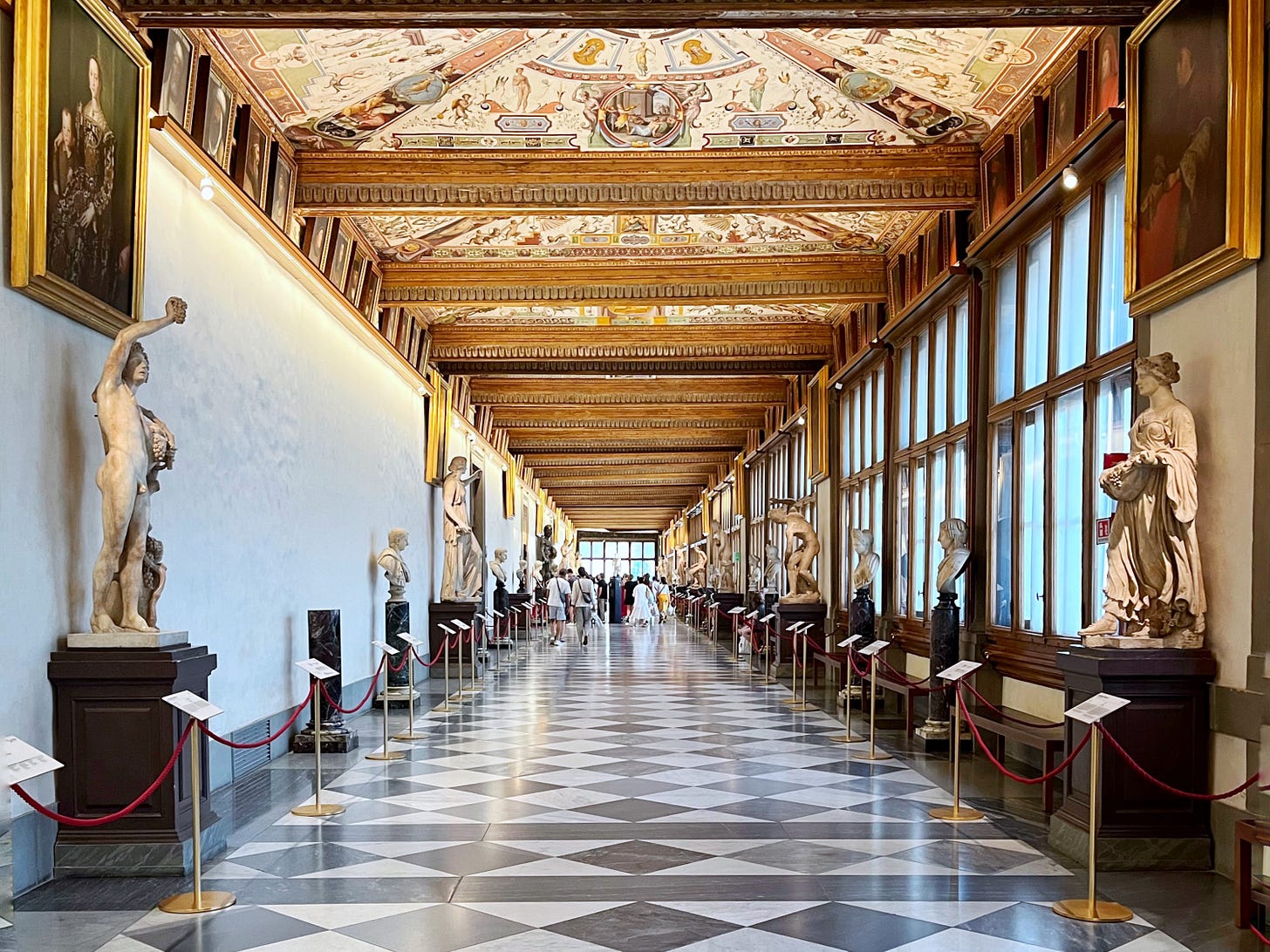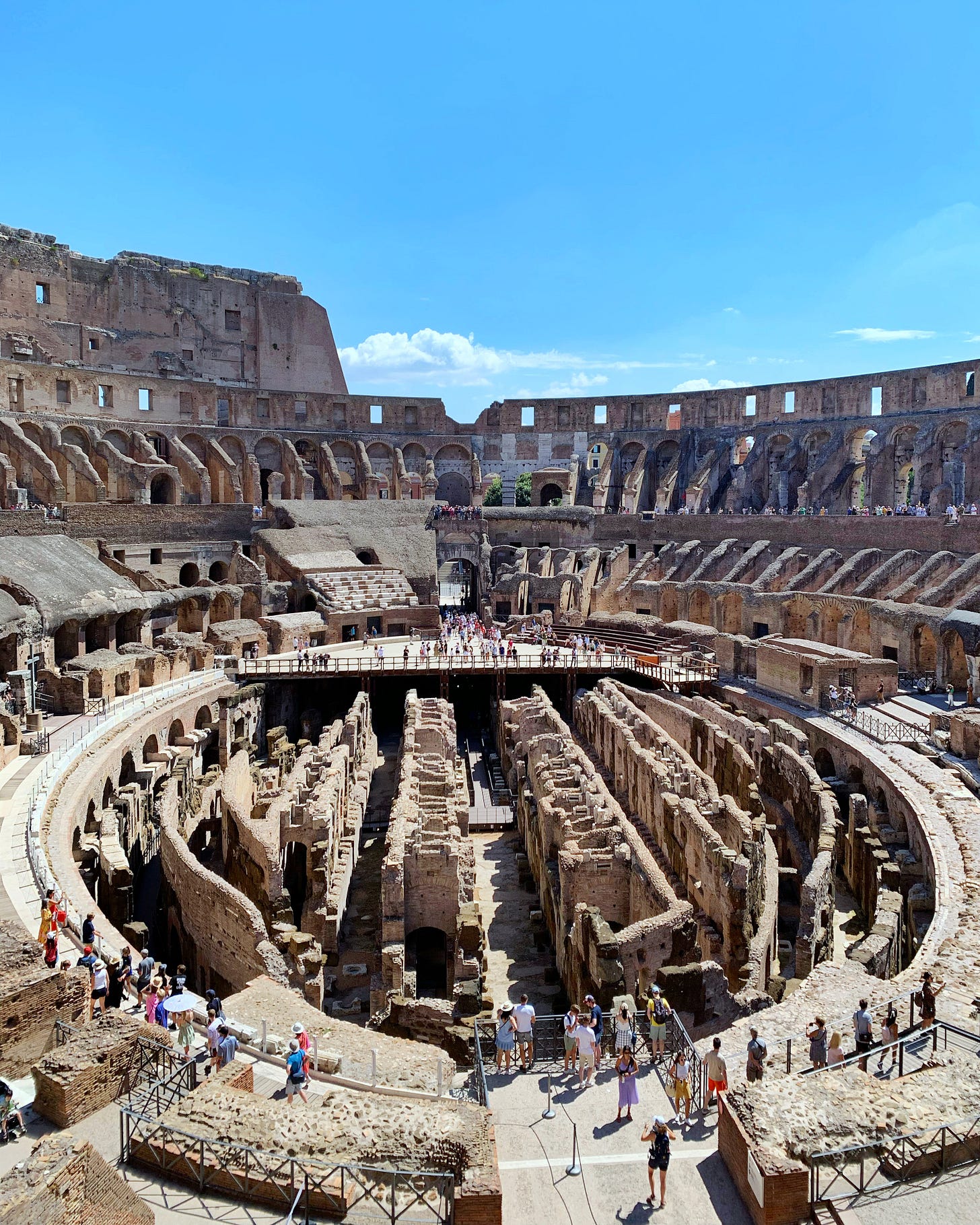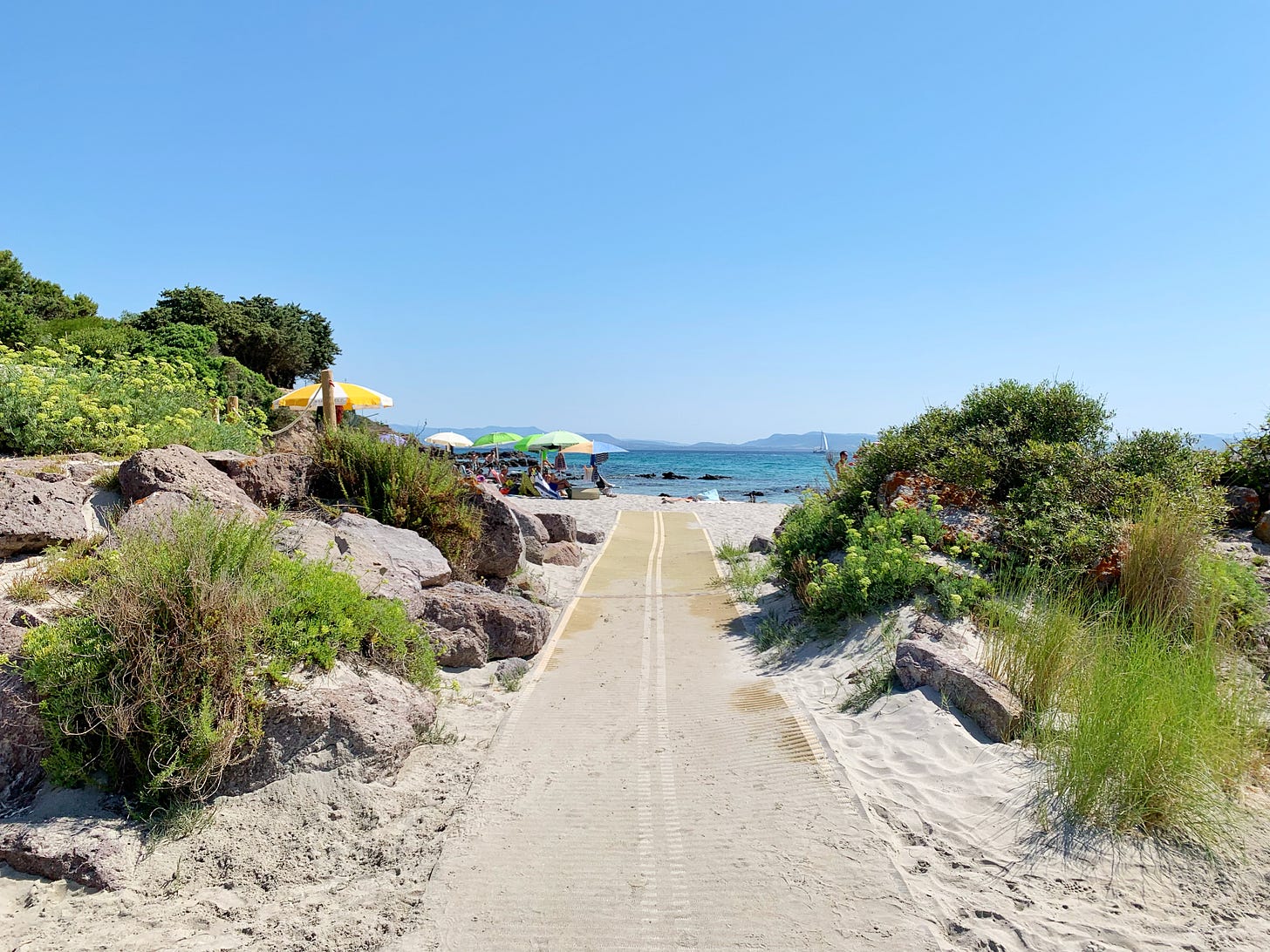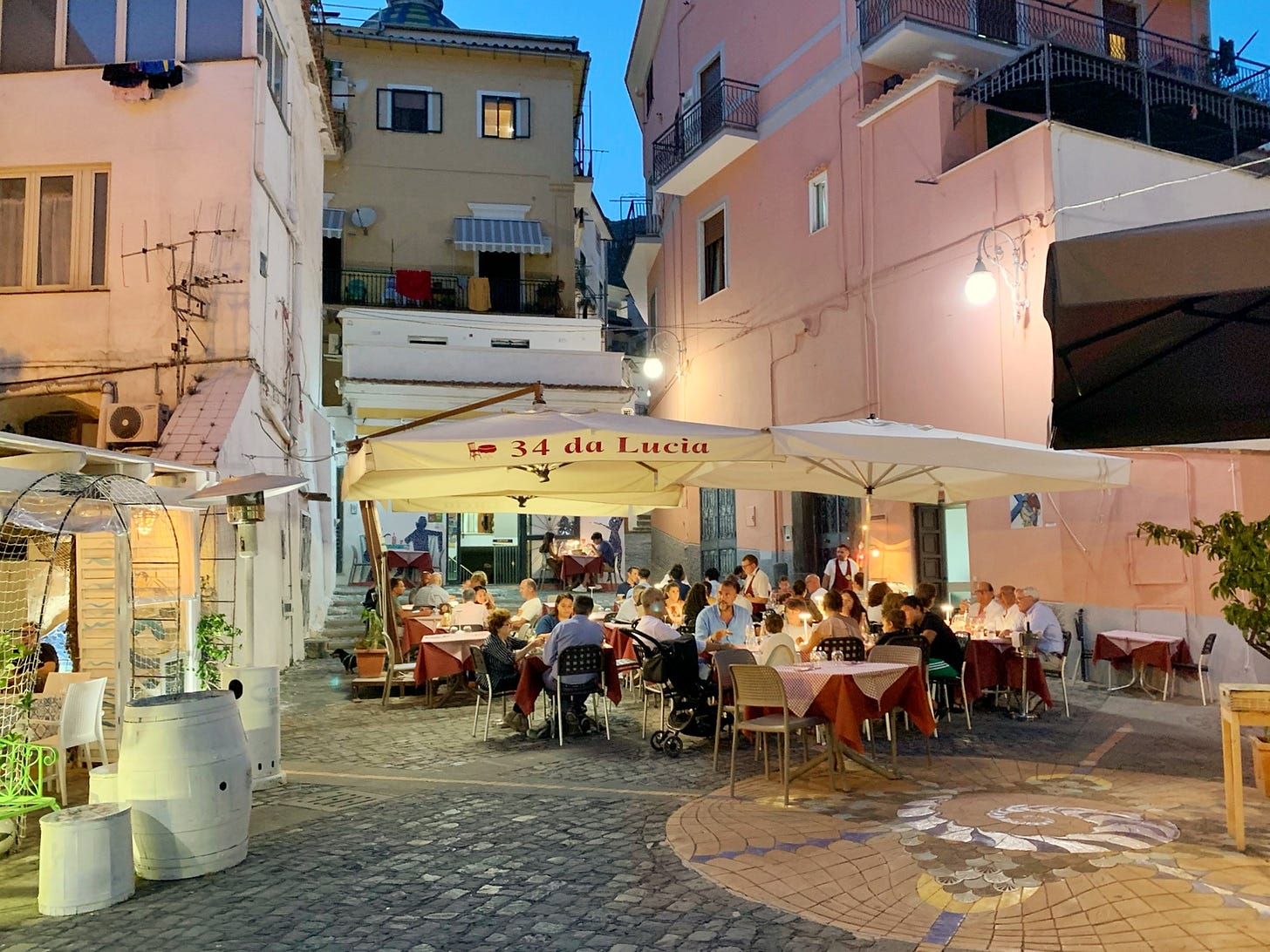Google ‘the best and worst times to visit Italy’ and just about every source you find will tell you that the best months to visit Italy are April and May or September and October and that the worst times to visit are July and August, when the weather gets uncomfortably hot and high season brings high prices and crowds. But what if the summer is the only time you’re available?
Personally, I love spending lazy days at Italian beaches and, while I have spent plenty of time by the sea during the spring and fall, it’s just not the same. When the temperature hits 85 or higher and I start to sweat just stepping outside, I feel the siren call of the sea—its cool waves promising relief. When my husband Marco and I take a beach day, we aim to arrive around 10 a.m. so we can get a good spot at a beach club, where we’ll rent sunbeds and an umbrella for the day. I bring a book or magazine, slather on sunscreen, and take plenty of cooling dips in the sea.
Sometimes we bring sandwiches from home, but I love going for a long lunch when we go to a beach club with a good restaurant. Afterwards, we retreat back to our sunbeds for a nap in the shade of the umbrella and maybe another swim before heading home or back to our hotel if we’re traveling. After freshening up, we might have an aperitivo or a leisurely stroll before dinner. This, to me, is an ideal summer day in Italy.
Traipsing around Rome, Florence, Venice, or any other city for that matter, waiting in long lines under the blazing sun to get into tourist attractions, and cramming myself onto hot, crowded metros and buses—that’s less than ideal. But readers often ask me for advice about visiting Italy in the summer because it’s the only time of year they can go—and I realize that many of them will be spending time in cities.
Having spent many summers in Italy—both in Rome and traveling around the country—I can reassure you that if you can only come in the summer, all is not lost. You’ll just have to plan your trip strategically if you want to avoid the crowds and the heat. Here are my personal tips, as well as some tips from my friend Sammi DiBacco, a fellow Rome-based writer, content creator and consultant.
Adjust Your Hours
If you’ve ever wondered why many shops in Rome and throughout Italy close for a few hours in the afternoon (usually from 1 p.m. to 3 or 4 p.m.), the summer heat is one of the reasons why. Fodor’s Rome guidebook, which I update every year, says, “Summers are often sweltering so come in July and August if you like, but we advise doing as the Romans do—get up and out early, seek refuge from the afternoon heat, resume activities in the early evening, and stay up late to enjoy the nighttime breeze.”
Luckily, there are plenty of ways to enjoy the summer evenings in Italy. Some attractions, like the Colosseum, offer evening tours and many museums and monuments stay open late on certain days of the week. Last summer, when I had to go to Florence for work in July, I checked the Uffizi’s opening hours and found that it was open until 10 p.m. on Tuesdays, so I went around 7 p.m. and was able to soak in the building’s beauty and gaze at paintings by Raphael and Botticelli without the crowds. I have also done evening tours of the Colosseum and the Valley of the Temples in Agrigento. In addition to avoiding the heat, seeing these monuments illuminated at night is pretty spectacular.
It’s always worth checking to see if evening hours and tours are available or booking the last possible entry slot in the late afternoon. Otherwise, consider doing your sightseeing as early as possible in the morning, especially if you plan to visit archeological sites, which often have limited shade and places to sit. A few summers ago, I toured the Roman Forum, Palatine Hill, and Colosseum with Elisa Valeria Bove, an archeologist and CEO of Roma Experience. We started around 9 a.m. and finished around lunchtime. It got pretty hot as the day wore on, but it was definitely doable. Isabella Calidonna, who leads running tours through ArcheoRoma, typically begins her tours at 6 a.m. during the summer months in order to avoid the heat.
Book Ahead
There’s been a lot of fuss this year about crowds due to the Jubilee, but demand for tours is always high during the summer, so if you want to travel in Italy during the peak months of June, July, and August, planning ahead is crucial. “Colosseum tickets release 30 days in advance and sell out quickly. Set your alarm for 8 a.m. Rome time to grab yours the moment they drop,” DiBacco advises. “Vatican Museums tickets are available now through the end of November, but most dates are already sold out through September. To skip the lines and get a deeper experience, book a guided tour with a trusted operator.”
With the exception of small museums, which don’t usually get crowded, you should be booking everything you can as far in advance as possible. If you plan to enlist the help of a tour operator like Fulvio De Bonis of Imago Artis Travel, Zoe Stella Shapiro of Stellavision Travel, or Elisa Valeria Bove of Roma Experience, contact them as soon as you know your dates (or possibly even before!). They all organize bespoke, private tours and Stellavision also organizes all inclusive group tours.
The same goes for booking your accommodations, train tickets, and even restaurants. Needless to say, as the dates of your trip approach, the price of hotels and Airbnbs will increase as rooms and apartments get booked up. And the longer you wait to book tickets on Italy’s high-speed trains, the more you’re going to pay.
Restaurants too, will book up in advance, especially the most in demand ones, such as Salumeria Roscioli and Armando al Pantheon. “If you have your heart set on a popular spot, book as far in advance as possible,” DiBacco says. “Otherwise, reserving a few dinners a week or two before your trip is usually enough.”
Consider Staying in Off-the-Beaten Path Neighborhoods or Towns
In July and August, Rome and other major cities tend to empty out as locals head off on vacation. I actually like being in Rome during this time because there’s less traffic and the streets are a bit calmer, especially in the weeks right before and after Ferragosto (the national holiday celebrated on August 15). That said, July and August are still fairly popular times for tourists to visit Rome, so if you find limited availability in the centro storico, consider staying in other neighborhoods, like Monti, Ostiense, Testaccio, or Pigneto. You’ll likely find you can get around with relatively little traffic.
Personally, I’m a big advocate of exploring under-the-radar regions, like Sardinia, Puglia, Umbria, and the Dolomites. For cooler temperatures, you could go hiking in the Dolomites, Abruzzo, or the Apuan Alps in Tuscany.
If you prefer the beach, consider relatively less crowded places like Menfi in Sicily, Carloforte in Sardinia, Maratea in Basilicata, and Tropea in Calabria. When it come to beaches, the general rule is that the more accessible they are, the more crowded they’ll be. To reach the least crowded beaches, you’re going to need a car.
Pack Appropriately
Just because it’s 100 degrees Fahrenheit, it doesn’t mean Italians will toss their fashion sense out the window. When going out to nice restaurants, you’re not likely to see many Italians wearing t-shirts and shorts, unless they’re at the beach. Breathable fabrics like linen and cotton are your best friend. If you plan to visit any churches, be sure to bring a light shawl or something to cover your shoulders.
Sandals are fine, but you won’t see Italians wearing flip flops in cities like Rome; those are strictly for the beach. You might also want to carry a hand-held fan and a water bottle, which you can refill at the fontanelle (the little fountains spouting cold water all over Rome).
“Everyone knows to pack light linen and cotton clothes, but the real must-have? A handheld electric fan,” says DiBacco. “I swear by it—even if it screams ‘tourist.’ That little breeze while you’re melting at dinner with barely-there air conditioning can make all the difference between misery and comfort.”
How do you stay cool during Italian summers? Share your tips with me and other readers in the comments!
Further Reading
In 2019, I wrote about the best times to visit Italy for The Points Guy. The data is likely outdated, but many of the general tips still hold true.
Planning to visit Italian beaches this summer? Check out my guide to European beach etiquette for The Points Guy.
Be sure to check out
’s Substack, , and follow her on Instagram, TikTok, or YouTube for more Italy tips and opinionated takes.I loved
’s recent Substack post, the Italian nonna’s guide to surviving summer, which is packed with fun observations and clever tips.Want to know where you can find me during the summer? Check out my very subjective list of the best beach towns near Rome.
For inspiration about under-the-radar places to visit in Italy in the summer, check out my postcards from Tropea, Ortigia, Maratea, Sorrento, and Forte dei Marmi.










Solid advice 👏
We were in Italy in August last year. It was hot, but we napped/rested at the hotel at the hottest point of the day!